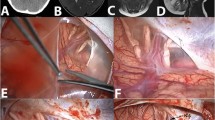Abstract
Arachnoid cysts (AC) occur in different intracranial locations. Management and prognosis depend on the clinical presentation and treatment guidelines do not exist. With this study, we want to demonstrate the clinical variety of arachnoid cysts in children and place a focus on outcome factors in operated cases. This retrospective study of a consecutive single unit series of children, who underwent AC surgery between January 2010 and September 2019, provides demographic, clinical, imaging data, and information about surgical treatment and outcome. Overall, 63 patients (71.4 male) underwent surgery. Mean age was 50 months (0–191). Mean follow-up was 40 months (0–121). Eighty-one percent of patients presented with symptoms/signs of raised ICP. Focal neurological deficits were present in 15.9%, headache in 11.1% of children. Galassi cysts represented the predominant type (30.2%), followed by suprasellar (14.3%), quadrigeminal (12.7%), retrocerebellar, CPA and midline (each 11.1%), and hemispheric cysts (7.9%). Endoscopic and microsurgical fenestrations were performed in 27% and 58.7%, stent or shunt insertion in 6.3%/57.9% of the cases. In 33.3% of the cases one and in 12.7%, a second reintervention became necessary. Reoperation rate was significantly higher in children < 1 year (p = 0.003). Cyst volume decreased in 85.7%. Seventy percent of the patients were symptom free, 5% suffered from headache, and 22% from developmental disorders. All focal neurological symptoms resolved. Complication rate and outcome are depending on age and cyst location. Recurrence and revision rates are significantly higher in young infants (p = 0.003). Midline cysts with CCA are associated with developmental disorders.



Similar content being viewed by others
Data availability
Not applicable.
Code availability
Not applicable.
References
Agopian-Dahlenmark L, Mathiesen T, Bergendal Å (2020) Cognitive dysfunction and subjective symptoms in patients with arachnoid cyst before and after surgery. Acta Neurochir (Wien) 162(5):1041
Al-Holou WN, Terman S, Kilburg C et al (2013) Prevalence and natural history of arachnoid cysts in adults. J Neurosurg 118(2):222–231
Ali M, Bennardo M, Almenawer SA et al (2015) Exploring predictors of surgery and comparing operative treatment approaches for pediatric intracranial arachnoid cysts: a case series of 83 patients. J Neurosurg Pediatr 16(3):275–282
Barkovich AJ, Simon EM, Walsh CA (2001) Callosal agenesis with cyst: a better understanding and new classification. Neurology 56(2):220–227
Catala M, Poirier J (1998) Les kystes arachnoïdiens : mise au point histologique, embryologique et physio-pathologique [Arachnoid cysts: histologic, embryologic and physiopathologic review]. Rev Neurol (Paris) 154(6–7):489–501
Galassi E, Gaist G, Giuliani G et al (1988) Arachnoid cysts of the middle cranial fossa: experience with 77 cases treated surgically. Acta Neurochir Suppl (Wien) 42:201–204
García-Conde M, Martín-Viota L (2015) Quistes aracnoideos: embriología y anatomía patológica [Arachnoid cysts: Embriology and pathology]. Neurocirugia (Astur) 26(3):137–142
Gjerde PB, Litleskare S, Lura NG et al (2019) Anxiety and depression in patients with intracranial arachnoid cysts-a prospective study. World Neurosurg 132:e645–e653
Halani SH, Safain MG, Heilman CB (2013) Arachnoid cyst slit valves: the mechanism for arachnoid cyst enlargement. J Neurosurg Pediatr 12(1):62–66
Kim KH, Lee JY, Phi JH et al (2020) Long-term outcome of large sylvian arachnoid cysts: the role of surgery has been exaggerated. J Neurosurg Pediatr 15:1–7
Pitsika M, Sgouros S (2019) Volume change of cranial arachnoid cysts after successful endoscopic fenestration in symptomatic children. Childs Nerv Syst 35(12):2313–2318
Martínez-Lage JF, Poza M, Sola J, Puche A (1992) Congenital arachnoid cyst of the lateralventricles in children. Childs Nerv Syst 8(4):203–6. https://doi.org/10.1007/BF00262846
Okano A, Ogiwara H (2016) The effectiveness of microsurgical fenestration for middle fossa arachnoid cysts in children. Childs Nerv Syst 32(1):153–158
Rengachary SS, Watanabe I (1981) Ultrastructure and pathogenesis of intracranial arachnoid cysts. J Neuropathol Exp Neurol 40(1):61–83
Sandvik U, Adolfsson T, Jacobson DN et al (2020) Cognition in children with arachnoid cysts. J Clin Med 9(3):850
Schertz M, Constantini S, Eshel R et al (2018) Neurodevelopmental outcomes in children with large temporal arachnoid cysts. J Neurosurg Pediatr 21(6):578–586
Schulz M, Kimura T, Akiyama O et al (2015) Endoscopic and microsurgical treatment of Sylvian fissure arachnoid cysts-clinical and radiological outcome. World Neurosurg 84(2):327–336
Shim KW, Lee YH, Park EK et al (2009) Treatment option for arachnoid cysts. Childs Nerv Syst 25(11):1459–1466
Struck AF, Murphy MJ, Iskandar BJ (2006) Spontaneous development of a de novo suprasellar arachnoid cyst. Case report J Neurosurg 104(6 Suppl):426–428
Yahal O, Katorza E, Zvi E et al (2019) Prenatal diagnosis of arachnoid cysts: MRI features and neurodevelopmental outcome. Eur J Radiol 113:232–237
Author information
Authors and Affiliations
Contributions
All authors contributed to the study conception and design. Material preparation, data collection, and analysis were performed by STJ, JE, PO, and MM-J. The first draft of the manuscript was written by STJ and MM-J. All other authors were involved in the clinical management of the cases. All authors commented on previous and actual versions of the manuscript.
Corresponding author
Ethics declarations
Ethics approval
Not applicable.
Consent to participate
Not applicable.
Consent for publication
All authors read and approved the final manuscript for publication.
Competing interests
The authors declare no competing interests.
Additional information
Publisher's note
Springer Nature remains neutral with regard to jurisdictional claims in published maps and institutional affiliations.
Rights and permissions
About this article
Cite this article
Jünger, S.T., Knerlich-Lukoschus, F., Röhrig, A. et al. Clinical variety and prognosis of intracranial arachnoid cysts in children. Neurosurg Rev 45, 3171–3178 (2022). https://doi.org/10.1007/s10143-022-01809-0
Received:
Revised:
Accepted:
Published:
Issue Date:
DOI: https://doi.org/10.1007/s10143-022-01809-0




